There’s something comforting and satisfying about noodles. Whether the word noodles makes you think of your childhood mac ‘n’ cheese, spaghetti, ramen, or stroganoff or just chicken noodle soup – noodles are comfort food. However, there are many reasons to stave off indulging in their starchy comfort including dietary restrictions, food sensitivities, blood sugar anomalies, or even cancer. Vegetable noodles – noodles made by cutting firm colourful vegetables into long julienne strips, are delicious on their own and satisfy your noodle craving. They may even help you to lose weight or beat cancer.
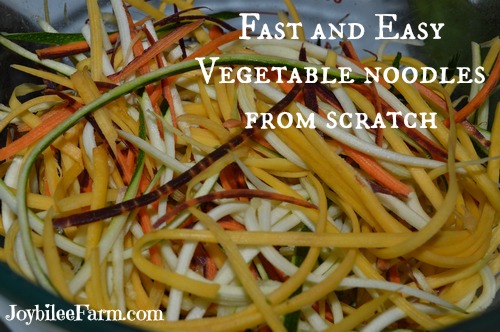
Why you want to learn how to make vegetable noodles
Vegetable noodles are a healthier choice than white pasta
Vegetable noodles are a healthy option when you are avoiding wheat, starches, or calories. Vegetable noodles are lower in calories, higher in vitamins and minerals, and easier to make and cook than wheat pasta or gluten-free pasta. And best of all, if you are avoiding wheat – vegetable noodles give you the al dente feel in your mouth, without the blood sugar hike that ramen noodles give you. I was blown away by how much they satisfy my noodle need. Next year I’m definitely going to grow noodles in my garden.
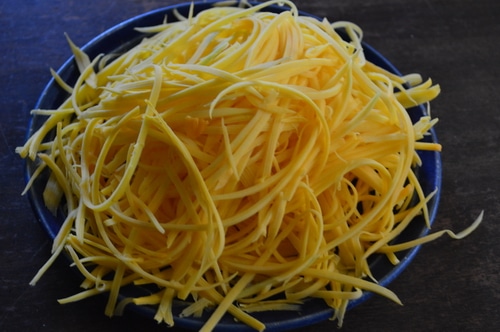
Vegetable noodles can help you fight cancer
Eating vegetable noodles also helps you increase the fruits and vegetables in your diet. Brightly coloured fruits and vegetables increase the antioxidants in our bodies, help us detoxify, and can be part of preventing diseases like cancer. Eating a diet full of brightly coloured fruits and vegetables helps fight cancer in a process called anti-angiogenesis, cutting off the blood supply to cancerous cells, inhibiting their growth. Vegetables that are perfect for making vegetable noodles are also vegetables that we can enlist in the fight against cancer – like butternut squash, zucchini, carrots, beets, radishes, and sweet potatoes. (See “Eat to Beat” to learn about the foods you can eat that will help you beat cancer.)
Check out this TED talk by Dr. William Li about the way colourful fruits and vegetables cut off the blood supply to cancerous cells and cause them to self-destruct. Keep watching till the end of the video — they found a link between anti-angiogenesis and weight loss, too. That made me more motivated to plant a veggie noodle garden next year.
Making vegetable noodles is easier than making pasta
You don’t need a fancy spiralizer that takes up lots of counter space, with so many pieces that you spend more time washing up than actually using the gadget. You can make vegetable noodles with just a Julienne peeler and have enough to serve 4 people in less time than it takes to boil a pot of water. In fact, vegetables can be cut into noodles, and stir-fried with onions, garlic, a dash of sesame oil, and other vegetables, before the pot of water for ramen is even boiled. The Julien peeler that I use is also a regular peeler and cleans up as fast as a box grater or a kitchen knife. (If you haven’t bought one yet grab the coupon before you do.)
Making vegetable noodles is faster than making pasta
They are a healthy, fast food option when you are in a hurry. They can be eaten raw, lightly steamed, or quickly stir-fried. You just need a julienne peeler and a long, cylindrical vegetable.
Which vegetables can be made into vegetable noodles
You already know vegetable noodles can be made out of zucchini. Those are called zoo noodles. But did you know that any long, cylindrical-shaped vegetable can be made into vegetable noodles? The possibilities are only limited by what you grow in your garden or can purchase from your local farmer’s market.
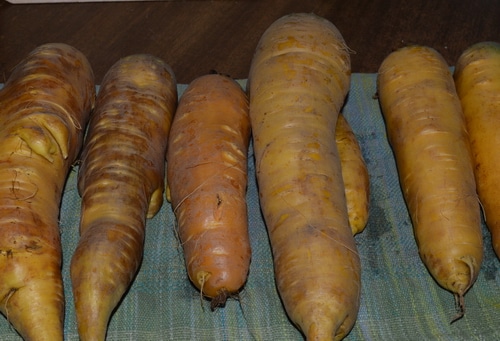
The ideal vegetable to use for veggie noodles should be at least 6 – 8 inches long and of firm flesh. Butternut squash, cylindrical beets, carrots, daikon radishes, immature spaghetti squash, pumpkin, cucumbers, yams, and sweet potatoes are just some of the vegetables you can turn into delicious, low calorie, nutrient-dense noodles. Avoid watery or starchy vegetables like regular potatoes because the high starch content and moisture will gum up your cooking pot and they don’t hold their shape when cooked.
Preparing vegetables
If the peel is hard or dirty you can peel it first, but many vegetables don’t need to be peeled before you make noodles out of them. A light scrubbing underwater, with a brush, is all they need. Carrots, daikon radishes, zucchini all just need to be washed. Vegetables like winter squash or pumpkin, of course, need to be peeled unless they are immature with soft skin. The skin of these mature vegetables is too fibrous to eat.

How to make vegetable noodles
With the julienne peeler that I use, the thickness of the noodle is determined by how hard you press the peeler into the flesh of the vegetable as you make your stroke down the length of it. The harder you press, the thicker the vegetable noodles. You’ll want to play a bit and decide what your ideal thickness is for your cooking. If they aren’t uniform in thickness with your first attempts, no problem. The cooking pot is forgiving and the vegetable noodles turn out even if the julienne thickness varies.

Consider using several colours of vegetables when you make your noodles – red cylindrical beets, yellow Amarillo carrots, orange butternut squash, and pale daikon radishes or sweet potatoes make a stunning and attractive vegetable noodle plate when mixed and matched.
Safety first
Do watch your fingers as you are using the julienne peeler. The peeler is very sharp and if you accidentally get your fingertips in the way of the blade it will hurt. I use a fork to anchor the vegetable on a cutting board as I’m peeling the julienne strips from the main vegetable. You can also wear a glove or leather fingertip guard to protect your hands. But although I offer this warning, it’s not a dangerous tool to use. Normal knife precautions will keep your fingers safe.
4 Fast and satisfying vegetable noodle dishes for days when there’s no time to cook
Here are the vegetable noodle dishes I fall back on when I’m in a hurry:
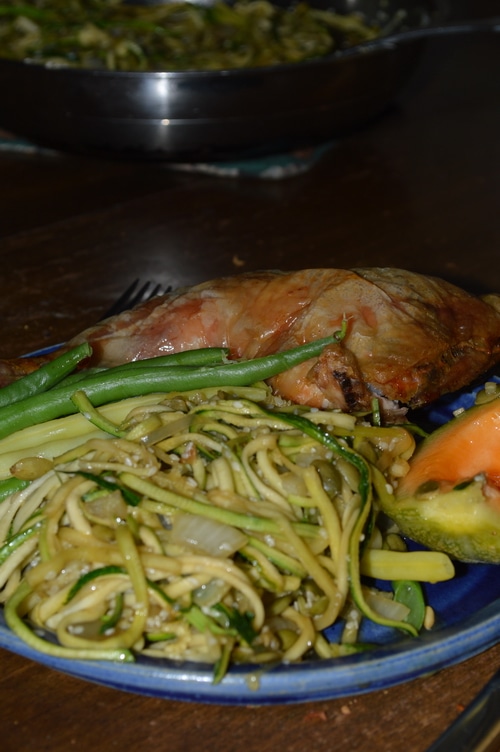
1. Stir Fry Sesame veggie noodles with leftover meat (20 min.)

2. Poppyseed Buttered vegetable noodles (10 min.)
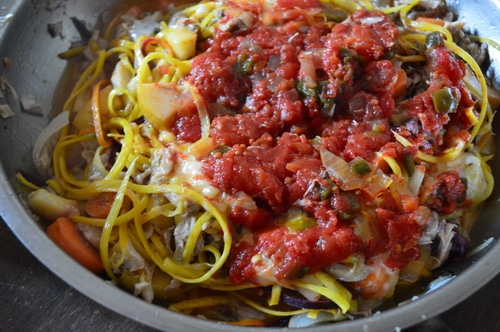
3. Spaghetti Veggie Noodles (15 min. )
Prepare veggie noodles. Stir fry until just limp.
In the meantime heat a jar of spicy tomato sauce that you canned during the harvest season. Add leftover ground beef, ground lamb, or seafood or prepared lentils if desired. Serve the tomato sauce over the cooked vegetable noodles and top with grated cheese.
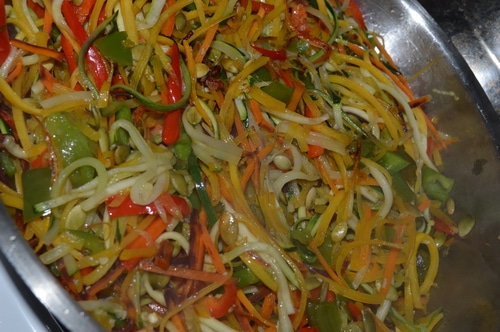
4. Quick alfredo sauce with Veggie Noodles (25 min.)
5. Low Carb Zucchini Noodles
Take action
Get yourself a julienne peeler and start on the path to better health this winter by making fast and easy vegetable noodles — “voodles” — the next time you are looking for comfort food. The julienne peeler makes a great hostess gift, neighbour gift, and gardener gift. So grab two and use the coupon. I bought two since I liked the first one so much.
If you are looking for more recipes check out Zucchini noodles.
Print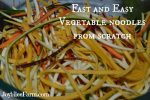
Fast and Easy Vegetable Noodles from Scratch
Description
Vegetable noodles are a healthy option when you are avoiding wheat, starches, or calories. Vegetable noodles are lower in calories, higher in vitamins and minerals, and easier to make and cook than wheat pasta or gluten-free pasta.
Ingredients
Your choice of vegetables – consider carrots, daikon radish, zucchini, sweet potato, winter squash, or pumpkin.
Instructions
With a julienne peeler or sharp knife, cut uncooked vegetables into long strips.
The thickness of the noodle is determined by how hard you press the peeler into the flesh of the vegetable as you make your stroke down the length of it. The harder you press, the thicker the vegetable noodles.
Cook in a boiling pot of water for 5 minutes, until al dente.
Notes
You’ll want to play a bit and decide what your ideal thickness is for your own cooking. If they aren’t uniform in thickness with your first attempts, no problem. The cooking pot is forgiving and the vegetable noodles turn out even if the julienne thickness varies.
Carrots, daikon radishes, zucchini all just need to be washed. Vegetables like winter squash or pumpkin, of course, need to be peeled unless they are immature with a soft skin. The skin of these mature vegetables is too fibrous to eat.


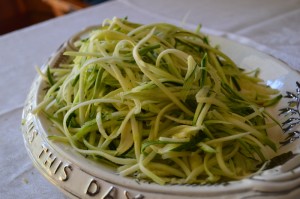

I’m getting a lot of use out of my 2 Julienne peelers. I’m amazed at all the veggies that taste better as noodles. Sweet potatoes are amazing.
This is so clever, and beautiful too! Brilliant, I’m going to check out that Julienne peeler deal now, thanks!